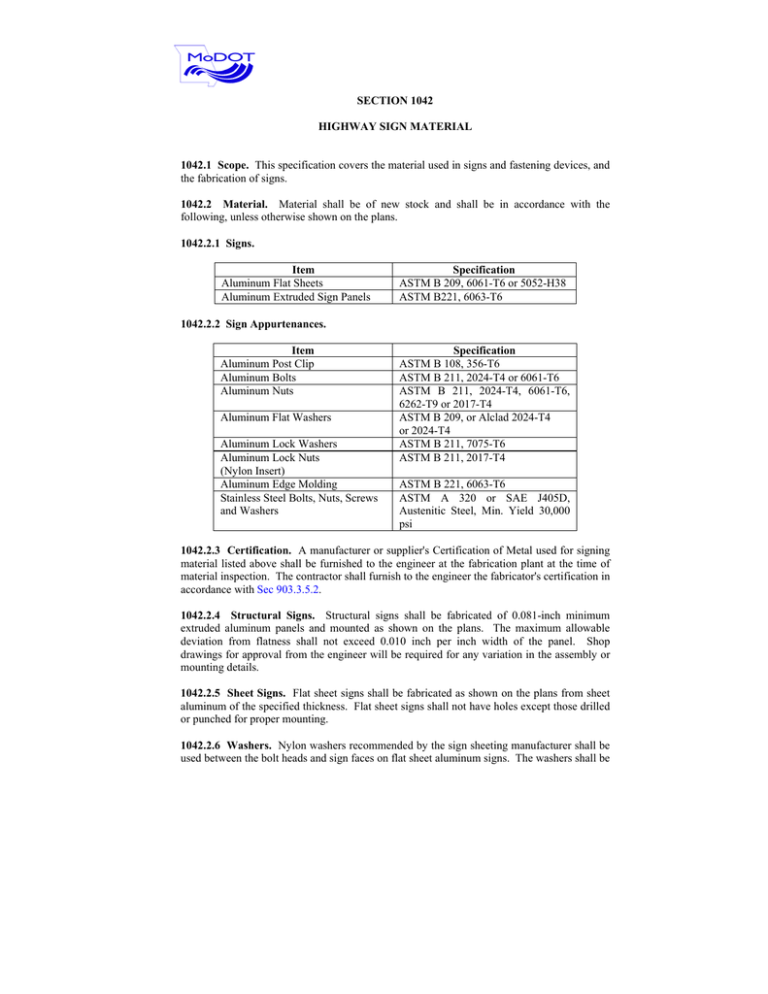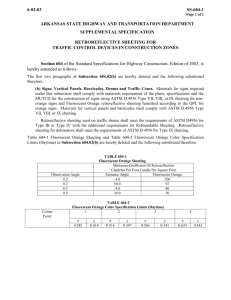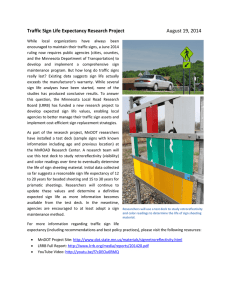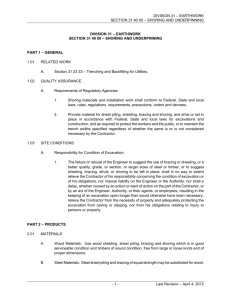SECTION 1042 HIGHWAY SIGN MATERIAL 1042.1 Scope. This
advertisement

SECTION 1042 HIGHWAY SIGN MATERIAL 1042.1 Scope. This specification covers the material used in signs and fastening devices, and the fabrication of signs. 1042.2 Material. Material shall be of new stock and shall be in accordance with the following, unless otherwise shown on the plans. 1042.2.1 Signs. Item Aluminum Flat Sheets Aluminum Extruded Sign Panels Specification ASTM B 209, 6061-T6 or 5052-H38 ASTM B221, 6063-T6 1042.2.2 Sign Appurtenances. Item Aluminum Post Clip Aluminum Bolts Aluminum Nuts Aluminum Flat Washers Aluminum Lock Washers Aluminum Lock Nuts (Nylon Insert) Aluminum Edge Molding Stainless Steel Bolts, Nuts, Screws and Washers Specification ASTM B 108, 356-T6 ASTM B 211, 2024-T4 or 6061-T6 ASTM B 211, 2024-T4, 6061-T6, 6262-T9 or 2017-T4 ASTM B 209, or Alclad 2024-T4 or 2024-T4 ASTM B 211, 7075-T6 ASTM B 211, 2017-T4 ASTM B 221, 6063-T6 ASTM A 320 or SAE J405D, Austenitic Steel, Min. Yield 30,000 psi 1042.2.3 Certification. A manufacturer or supplier's Certification of Metal used for signing material listed above shall be furnished to the engineer at the fabrication plant at the time of material inspection. The contractor shall furnish to the engineer the fabricator's certification in accordance with Sec 903.3.5.2. 1042.2.4 Structural Signs. Structural signs shall be fabricated of 0.081-inch minimum extruded aluminum panels and mounted as shown on the plans. The maximum allowable deviation from flatness shall not exceed 0.010 inch per inch width of the panel. Shop drawings for approval from the engineer will be required for any variation in the assembly or mounting details. 1042.2.5 Sheet Signs. Flat sheet signs shall be fabricated as shown on the plans from sheet aluminum of the specified thickness. Flat sheet signs shall not have holes except those drilled or punched for proper mounting. 1042.2.6 Washers. Nylon washers recommended by the sign sheeting manufacturer shall be used between the bolt heads and sign faces on flat sheet aluminum signs. The washers shall be for use with 3/8-inch bolts and shall have a minimum outside diameter of 3/4 inch, and a nominal thickness of 1/16 inch. 1042.2.7 Retroreflective Sheeting. Retroreflective sheeting shall be in accordance with latest versions or ASTM D 4956 and AASHTO M 268, except as noted herein. Color and luminance values for all MoDOT types of reflective sheeting shall be in accordance with ASTM D 4956. Retroreflective sheeting shall have sufficient adhesion, strength and flexibility such that the sheeting can be handled, processed and applied according to the manufacturer's recommendations without appreciable stretching, tearing, cracking or other damage. Adhesive performance for retroreflective sheeting shall be in accordance with ASTM D 4956. The sheeting surface shall be in condition to be readily screen processed and compatible with transparent overlay films, plus recommended transparent and opaque screen process colors. The retroreflective sheeting manufacturer shall furnish information as to the type of solvent or solvents that may be used to clean the surface of the sheeting without detrimental loss of performance and durability. Retroreflective sheeting having a datum mark on the surface shall be oriented vertically. ASTM D 4956 Type IX, XI or AASHTO M 268 Type C or D retroreflective sheeting applied as legend and border for specific signing applications, without a datum mark on the surface of the sheeting, shall be evaluated for rotational sensitivity per AASHTO M 268, Section 3.3. Retroreflective sheeting products that do not meet the rotational sensitivity requirements of Section 3.3 shall follow guidelines detailed in AASHTO M 268 Section 3.3.1 and fabricated per AASHTO M 268 Section 3.3.2. 1042.2.7.1 ASTM D 4956 Type I, Class 1 retroreflective sheeting shall be enclosed lens glass-bead or prismatic sheeting. 1042.2.7.2 Background sheeting applied to flat sheet and extruded panel signs shall be in accordance with ASTM D 4956 Type IV, Class 1. All yellow, orange and red sheeted signs shall be fabricated with ASTM D 4956 Type IX, XI or AASHTO M 268 Type C or D fluorescent yellow, fluorescent orange and prismatic red sheeting respectively. Retroreflective sheeting shall be high intensity that is an unmetallized micro prismatic reflective material. 1042.2.7.3 Retroreflective sheeting applied as legend and border shall be in accordance with ASTM D 4956, Type IX, XI or AASHTO Type C or D, Class 1.Retroreflective sheeting shall be an unmetallized cube corner microprismatic reflective material. 1042.2.7.4 Screen Print and Overlay. For screen printed transparent colored areas or transparent colored overlay films on white sheeting, the coefficient of retroreflection (RA) shall be no less than 70 percent of the original values for the corresponding color. 1042.2.7.5 Reflective sheeting for temporary traffic control devices and delineators shall be in accordance with Sec 1063 and Sec 1065 respectively. 1042.2.8 Outdoor Exposure. Retroreflective sheeting, except for work zone signs, shall be submitted by the manufacturer to NTPEP for two years of 45-degree south-facing outdoor exposure. Retroreflective sheeting for work zone signs shall be submitted by the manufacturer to NTPEP for an exposure time of one year. Results shall be published by NTPEP and available for MoDOT review. For all NTPEP test decks, retroreflective sheeting shall have a coefficient of retroreflection at least 50 percent of the specified value for ASTM D 4956 Type I or 80 percent of the original reading for ASTM D 4956 Type IV, IX or XI. 1042.2.9 Manufacturer and Brand Name Approval. The manufacturer shall make available, upon request, NTPEP test results from all test decks, and certification to Construction and Materials, showing reflective material is in accordance with ASTM D 4956 specification. In addition, the manufacture shall, upon request, submit samples representing the retroreflective sheeting tested by NTPEP, and with compatible inks. These samples shall be accompanied by a product data sheet, an MSDS, technical bulletins on sign fabrication and any special fabrication instructions relative to the retroreflective sheeting submitted. Samples of retroreflective sheeting shall 10 x 10 inches and applied to an aluminum substrate. 1042.2.9.1 Materials that fail to provide satisfactory field performance will be evaluated and may be disqualified from future use on fabricated signs for MoDOT. All corrective actions made by MoDOT will control. 1042.2.10 Type of Characters. Letters, numerals, arrows, symbols, borders and other features of the sign message shall be of the type, size and series shown on the plans or as specified by the engineer. Completed letters, numerals and other units shall be formed to provide a continuous stroke width with smooth edges, and shall yield a flat surface free of air bubbles, wrinkles or other blemishes as determined by the engineer. Units of the sign message shown on the plans shall meet the requirements for the specified type. Type L-1 and L-3 characters shall not be intermixed on a single sign face, unless otherwise shown on the plans or as approved by the engineer. 1042.2.10.1 Type L-1 Characters. 1042.2.10.1.1 The letters, numerals, arrows, symbols and borders shall be applied to the background of the sign by the direct or reverse screen process. Messages and borders of a color darker than the sign field shall be applied to the retroreflective sheeting by the direct process. Messages and borders of a color lighter than the sign field shall be produced by the reverse screen process. Inks used in the silkscreen process shall be of the type to produce the desired color and durability when applied on retroreflective sheeting. Silkscreen inks shall be used in accordance with the manufacturer's recommendations. The ink shall produce the desired color when applied on retroreflective sheeting background and shall dry to a good film without running, streaking or sagging. The screening shall be done in a manner that results in a uniform color and tone, with sharply defined edges of legend and border without blemishes on the sign field that will affect the intended use. Signs after screening shall be dried in accordance with the manufacturer's recommendations to provide a smooth hard finish. Any signs on which blisters appear during the drying process will be rejected. 1042.2.10.1.2 Transparent overlay films may be used as a replacement for the reverse screen process, as recommended by the sheeting manufacturer. 1042.2.10.2 Type L-3, Direct Applied Characters. The letters, numerals, symbols, borders and other features of the sign message shall be cut from the color and type of sheeting shown on the plans, and applied to the sign field in accordance with the sheeting manufacturer’s recommendations. 1042.2.10.3 Allowable Variations. The design height of rounded letters or numerals shall be 1/64 inch of height greater than normal height, both on top and bottom of letter or numeral, where rounded. The loop portion of letters such as f, g and y, shall conform to the dimensions shown on the plans with the allowable tolerance. The following variations in dimensions of letters and numerals, regardless of character type, will be acceptable with all measurements made to the nearest 1/8 inch. Nominal Height, inches 4 thru 12 Over 12 Allowable Variation Variation in Height, inches -1/8 to +3/8 -1/8 to +3/8 Variation in Width, inches -1/4 to +1/4 -3/8 to +3/8 1042.3 Sign Fabrication. A sign shall consist of aluminum flat sheets or extruded panels retroreflectorized on the face side with all letters, numerals, symbols, borders, corners and route shields mounted on the face, and shall include all necessary mounting devices shown on the plans. Signs equal to or greater in width than six feet are considered structural (ST) and shall be fabricated on extruded panels. Signs less than six feet in width will be considered sheet (SH) signs and shall be fabricated with flat sheet. Any exceptions to these fabrication standards will be indicated on the plans. 1042.3.1 All signs shall be of the highest quality with consistent daytime and nighttime color and retroreflectivity throughout the sign and produced as follows. 1042.3.1.1 All aluminum substrate shall be given a chromate conversion coating in accordance with ASTM B 449, Class 2, and shall be prepared by one of the Treatment Sequence Options described in ASTM B 449, Appendix X2. The chemicals and solvents shall be applied in strict accordance with the manufacturer’s recommendations. Sufficient laboratory facilities to test and control the concentration of the solutions used shall be maintained at the treating plant. A log of the concentration of treating solutions shall be maintained. Treated panels shall be handled in such a manner as to prevent contamination. Panels shall be stored in a dry, clean area free from dust, acid fumes or vapors. When aluminum is shipped to a secondary location for retroreflectorizing, adequate precautions shall be taken to ensure that the material arrives at the destination uncontaminated. 1042.3.1.2 All materials used to fabricate a sign legend, including retroreflective and nonretroreflective sheeting, used for background, letters, numerals, arrows, symbols, borders and other features of the sign message shall be from a single manufacturer. 1042.3.1.3 Retroreflective sheeting splices on structural signs shall be kept to a minimum. Rolled overlap splices in accordance with the sheeting manufacturer’s recommendations may be used, with no more than one allowed per panel. Retroreflective sheeting shall be placed on the individual extruded panels in accordance with the manufacturer’s recommendations. The sign panels may be clear coated or edge sealed after application of the retroreflective sheeting, if recommended by the sheeting manufacturer. If edge sealer is used, the sealer shall be applied to all splices and edges. The completed sign shall have good color matching of retroreflective sheeting and shall be free from air bubbles, wrinkles or other blemishes. 1042.3.1.4 Retroreflective sheeting applied to standard flat sheet signs shall not have splices on signs where the smallest dimension is less than 4 feet. One vertical overlap splice approximately 1/4 inch wide will be allowed on standard flat sheet signs where the smallest dimension is greater than 4 feet. Any special flat sheet signs requiring splicing other than noted for the standard flat sheet signs shall be as approved by the engineer. The sign panels may be clear coated or edge sealed after application of the retroreflective sheeting if recommended by the sheeting manufacturer. If clear finish is used, the finish shall be applied after screening of messages and borders. If edge sealer is used, the sealer shall be applied to all splices and edges. The completed sign face shall be free from air bubbles, wrinkles or other blemishes. 1042.3.2 Nuts on panel bolts used to connect extruded panels together to form a structural sign shall be torqued to 220 - 230 inch-pounds. 1042.3.3 Signs will be accepted on certification from the manufacture assuring all fabrication and sheeting specifications are in compliance with all applicable requirements specified herein. Periodic shop inspections of sign fabrication will be made at the discretion of MoDOT, to include contractor furnished signs for MoDOT projects. Routine shop inspections will include inspection and sampling of materials, inspection of treatment and fabrication processes, and of any signs completed at time of inspection. Inspections on delivered signs for maintenance operations will be conducted for quality assurance purposes by the appropriate district inspectors. Signs may be rejected at the fabrication shop and/or upon delivery based on unsatisfactory workmanship and/or material applications or based on any aspect of the product that is not in accordance with the specifications. The contractor will be charged with the transportation costs of sign inspectors for trips from Jefferson City, Missouri to which the inspectors must travel for signs provided to MoDOT projects. Transportation costs will be deducted by the Commission from monies due the contractor. 1042.3.4 Signs shall be packaged and shipped according to the reflective sheeting manufacture’s recommendations. Signs fabricated and shipped to MoDOT for maintenance operations shall be shipped in accordance with manufacture’s recommendations and in a manner that meets the requirements of the engineer. All signs shall include decals indicating sign production date, lot number of reflective sheeting used in the production of sign and other information necessary for proper sign fabrication. Upon shipment of signs to MoDOT, certifications shall be submitted thereafter to Construction and Materials. Required paperwork shall include a certification statement indicating signs meet all applicable requirements herein to include aluminum standard and extruded panel, reflective sheeting (manufacturer, series and color), and hardware certifications. Material quantities, such as square foot of flat sheet, extruded panels, if produced, reflective sheeting and a shipping list of all signs shall be included in the certification packet.


